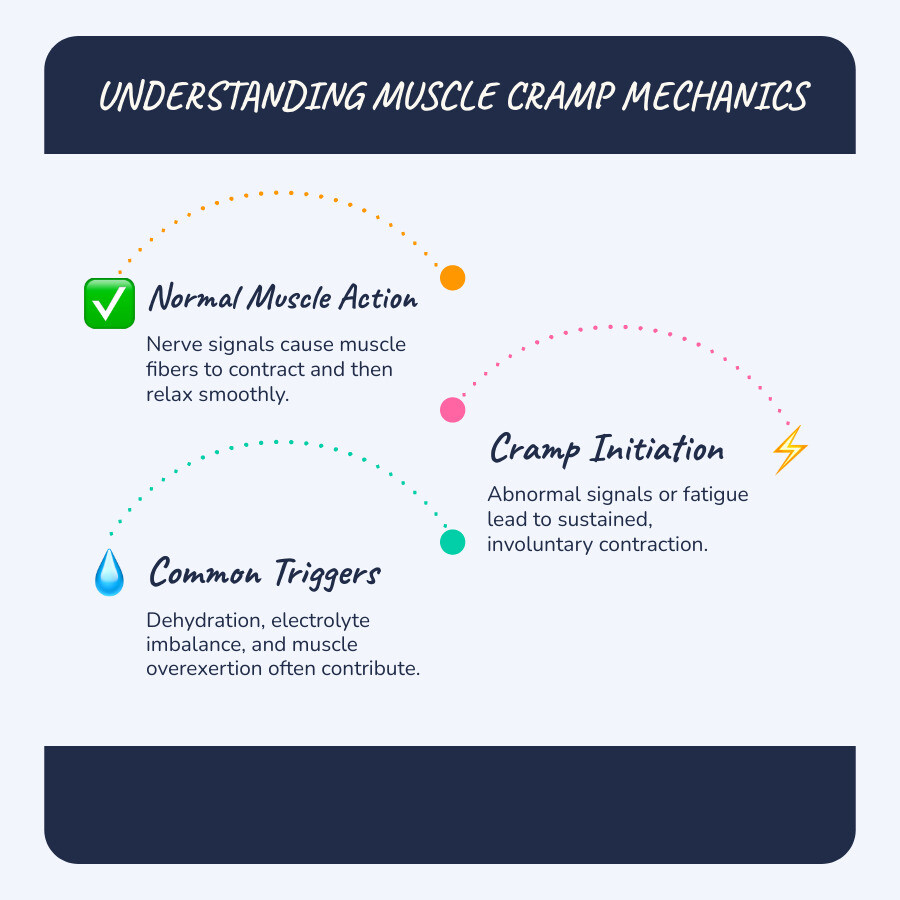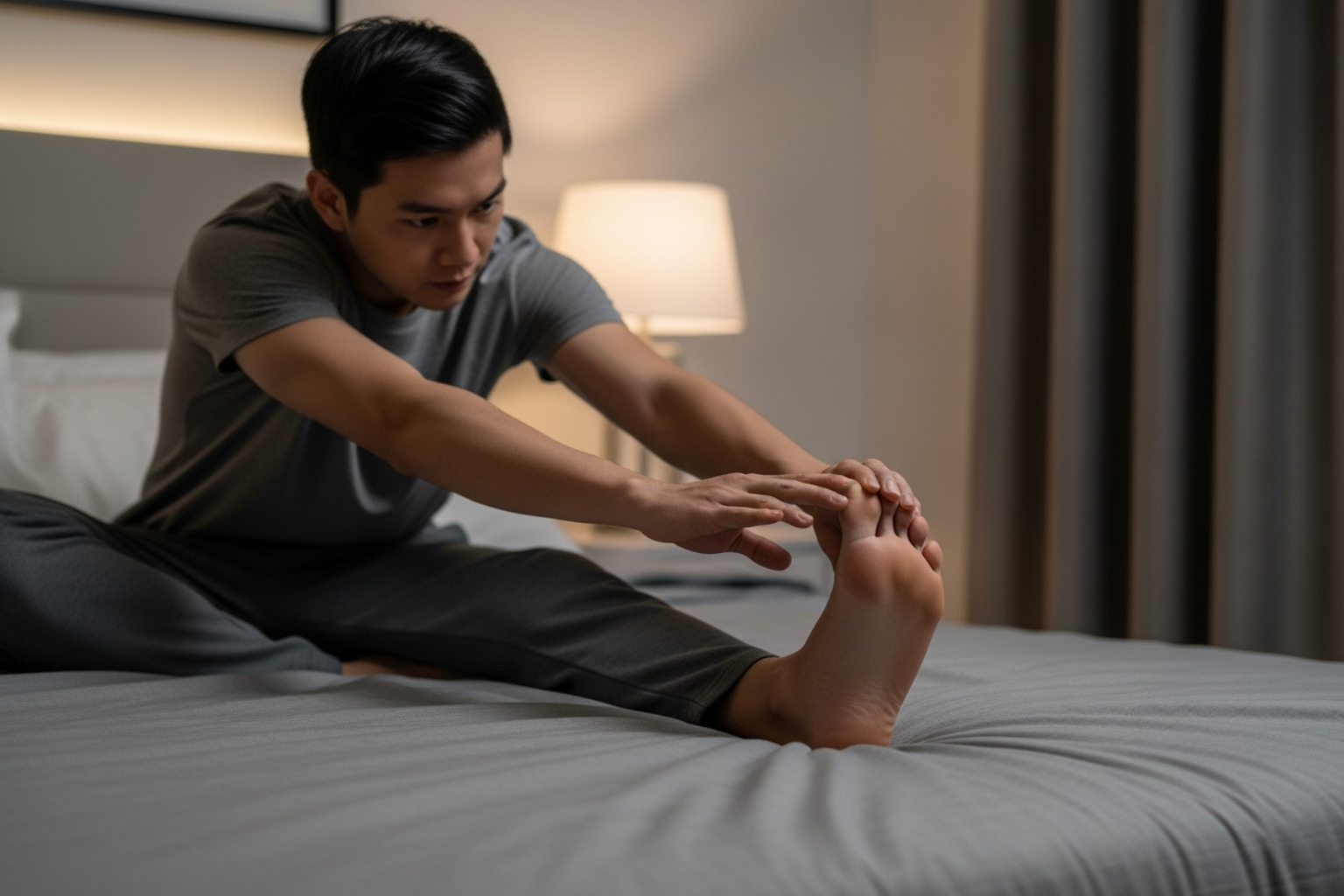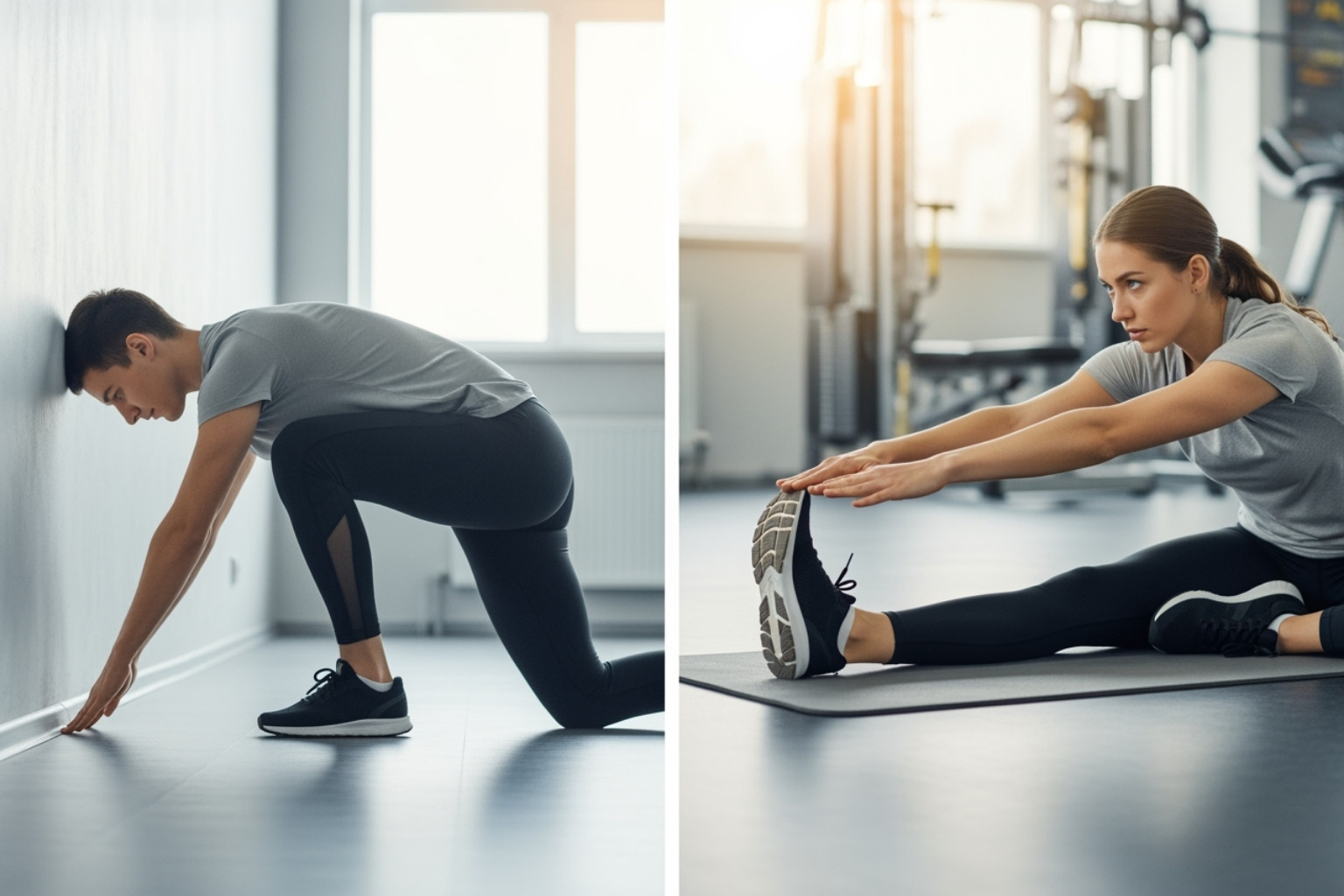Understanding the Grip of Muscle Cramps
Muscle cramps are sudden, involuntary, and often painful contractions of one or more muscles. Here's a quick overview:
- What they are: Forceful muscle contractions that can last from seconds to over 15 minutes [1].
- Where they happen: Most commonly in the calves, feet, thighs, hands, and arms [4].
- Who gets them: Nearly everyone experiences them at some point in their life [4].
- Common triggers: Muscle fatigue, dehydration, electrolyte imbalances, and overexertion [1].
- Quick relief: Stretching, gentle massage, applying heat or cold, and hydrating [3].
You know the feeling—drifting off to sleep when your calf muscle seizes up, or midway through a run when a hamstring locks tight. These painful, frustrating moments are what we call muscle cramps, or "charley horses."
Muscle cramps are incredibly common, becoming more frequent with age [4]. They can strike during exercise, at rest, or while you sleep. The pain can range from a mild twitch to an intense tightening that leaves the muscle sore for days.
Most muscle cramps are not a sign of something serious. They're often caused by simple things like pushing your body too hard, not drinking enough water, or running low on key minerals. Understanding your triggers is the first step to taking control.
I'm Tony Enrico, and at Neuropasil, we're dedicated to helping people find real relief from muscle cramps. This guide will walk you through what they are, why they happen, and how to stop them.

What Are Muscle Cramps and How Do They Feel?
A muscle cramp is an involuntary, continuous, and often excruciating contraction of a muscle that refuses to let go. Medically, it's a sustained contraction of a muscle or even just a few muscle fibers that won't relax [1]. Some cramps last just a few seconds, while others can persist for 15 minutes or more, sometimes recurring [1].
Nearly everyone has a muscle cramp at some time in their life [4]. They can strike almost any voluntary muscle, but the most common targets are the calves (often called a "charley horse"), feet, thighs, hands, arms, and abdomen [4].
The Sensation of a Muscle Cramp
When a muscle cramp strikes, the pain is sharp and immediate. The muscle becomes rock-hard and tight, and you might see a visible knot or lump under your skin [4]. The muscle may also twitch or jump uncontrollably.
Even after the worst of the pain subsides and the muscle releases, the area often remains tender and sore for hours or even a day or two [1]. This post-cramp soreness can interfere with daily activities, workouts, and sleep.
Muscle Cramp vs. Muscle Spasm: What's the Difference?
While often used interchangeably, "cramp" and "spasm" have a key difference. A muscle spasm is any sudden, involuntary muscle contraction. It can be a mild, painless twitch (like an eyelid) or more intense [1].
A muscle cramp is a specific type of spasm—one that is sustained, forceful, and almost always painful. It's the prolonged, intense tightening that demands immediate attention [1].
Here's how they stack up:
| Feature | Muscle Cramp | Muscle Spasm |
|---|---|---|
| Pain Level | Often severe and excruciating | Can be mild, moderate, or even painless |
| Duration | Sustained, from seconds to 15+ minutes | Brief, fleeting, or intermittent |
| Intensity | Forceful, involuntary tightening | Involuntary contraction, can be a subtle twitch |
| Muscle Feel | Hard, rigid, knot-like | May feel tight, but not always rigid or knot-like |
| Commonality | Very common, nearly everyone experiences them | Also common, can occur in any muscle |
| Relationship | A type of severe, sustained muscle spasm | A broader term, cramps are a specific type of spasm |
The bottom line: All muscle cramps are spasms, but not all spasms are cramps. When someone has a cramp, it's painful, persistent, and they're looking for fast relief.
Uncovering the Causes and Risk Factors for Muscle Cramps
Understanding why muscle cramps happen is the first step toward preventing them. While some cramps are idiopathic (have no known cause), most stem from a wide range of sources, from daily habits to underlying medical conditions. For a deeper dive, the Muscle Cramps - StatPearls - NCBI Bookshelf offers a comprehensive medical overview [1].
Common Triggers for Everyday Cramps
Most cramps are caused by manageable factors. The most common triggers include:
- Muscle fatigue and overexertion: Pushing muscles beyond their usual limits during exercise or physical labor [1].
- Dehydration: Inadequate fluid intake makes muscles irritable and more likely to seize up [1].
- Holding a position too long: Staying in an awkward position can compress nerves or restrict blood flow, leading to cramps [4].
- Inadequate stretching: Skipping warm-ups and cool-downs leaves muscles unprepared for activity and unable to relax properly afterward [1].
- Exercising in heat: This combines physical exertion with increased fluid and electrolyte loss through sweat, creating a perfect storm for cramps [1].
The Critical Role of Hydration and Electrolytes
Hydration and electrolytes are crucial for preventing muscle cramps. Electrolytes are minerals like sodium, potassium, calcium, and magnesium that carry electrical signals needed for muscle function [3]. When we sweat, we lose both water and these vital minerals, disrupting the signals and causing muscles to misfire.
Scientific research on electrolytes and cramps shows that the combination of dehydration and electrolyte imbalance is a major problem. In fact, drinking plain water after significant sweating without replacing electrolytes can actually make muscles more prone to cramping [2]. This is why sports drinks and electrolyte supplements are popular among athletes.
Specific Types of Muscle Cramps
Cramps can be categorized by when and why they occur:
- Nocturnal leg cramps: These jolt people awake, usually with a calf or foot cramp. They are common, affecting about 37% of people over 60 [1].
- Exercise-associated muscle cramps (EAMC): Striking during or after intense physical activity, EAMC is the most frequent medical issue requiring intervention during sports [1].
- Pregnancy-related cramps: Affecting about half of all pregnant women, these cramps often target the calves, especially in the second and third trimesters [1].
- Dystonic cramps: This type, like "writer's cramp," involves the contraction of muscles not needed for a specific movement. It's more of a neurological issue than an electrolyte one [1].

Medical Conditions and Medications That Can Cause Cramps
Frequent or severe muscle cramps can sometimes be a symptom of an underlying health issue or a side effect of medication.
Medical conditions linked to cramps include:
- Nerve compression: A pinched nerve in the spine can cause cramping pain down the leg [4].
- Poor circulation: Narrowed arteries (atherosclerosis) can reduce blood flow, causing pain and cramping during exercise [3].
- Metabolic issues: Conditions like diabetes (affecting up to 80% of patients with Type 2), kidney disease (affecting up to 50% on dialysis), and hypothyroidism are strongly associated with cramps [1, 3].
- Liver disease: An astonishing 88% of patients with cirrhosis report cramps [1].
- Neurological disorders: ALS, fibromyalgia, and certain neuropathies are also linked to frequent cramping [1].
Medications that may trigger cramps include:
- Diuretics (water pills)
- Statins (for cholesterol)
- Beta-blockers (for heart conditions)
- Certain drugs for Alzheimer's, osteoporosis, and asthma [4].
If you suspect your cramps are linked to a new medication or a persistent health issue, consult your doctor.
How to Find Relief and Prevent Future Muscle Cramps
When a muscle cramp hits, you are not powerless. There are effective ways to stop a cramp in its tracks and reduce the chance of it happening again. Most cramps respond well to simple self-care measures. At Neuropasil, we've seen what works, and for those seeking extra support, you can learn more about muscle cramp relief creams and how they fit into a relief strategy.
Immediate At-Home Treatments for Muscle Cramps
When a cramp strikes, you need relief now. Try these immediate remedies:
- Gentle stretching: This is your most powerful tool. Gently lengthen the contracted muscle. For a calf cramp, straighten your leg and pull your toes toward your head, or stand and press your heel to the floor [3]. For a hamstring cramp, sit with your leg extended and reach for your toes. Hold stretches gently without bouncing.
- Massage: Gently knead the knotted muscle to increase blood flow and encourage it to relax [3]. A foam roller can also be effective.
- Heat and Cold Therapy: A warm towel or heating pad can relax the muscle during a cramp [3]. Afterward, if the muscle is sore, a cold pack can reduce lingering pain and inflammation [3].

Many people also find topical relief creams offer targeted comfort. At Neuropasil, our natural creams with Aloe, Urea, and Menthol are designed to soothe sore, cramping muscles. They absorb quickly to help release tightness and reduce post-cramp soreness. For more tips, see our guide: Top 7 Effective Cures for Muscle Cramps: Fast Relief Tips.
Long-Term Prevention Strategies
Relief is good, but prevention is better. Most muscle cramps are preventable with consistent habits.
- Stay Hydrated: This is essential. Drink plenty of fluids throughout the day, not just when you're thirsty. You'll need more if you're active or in warm weather. During exercise, aim to prevent losing more than 2% of your body weight in sweat [4].
- Balance Your Electrolytes: A diet rich in potassium (bananas, avocados), magnesium (leafy greens, nuts), and calcium (dairy, fortified milks) helps muscles function smoothly [3].
- Stretch Regularly: Make stretching a daily habit, especially before and after exercise and before bed if you get night cramps. Hold each stretch for 20-30 seconds [3].
- Wear Proper Footwear: Supportive shoes reduce strain on your foot and leg muscles, especially if you're on your feet all day [4].
- Exercise Smart: Progress gradually with new workout routines. Always include a light warm-up and a cool-down with gentle stretching to help your muscles transition safely [3].
As Harvard Health Publishing notes, consistency with these fundamental strategies is key to preventing cramps and promoting overall muscle health [3].
When to See a Doctor for Your Muscle Cramps
Most muscle cramps are harmless, but sometimes they can be a red flag for an issue that needs professional attention. Knowing when to see a doctor is important for your health. The Mayo Clinic provides excellent guidance on these warning signs [4].
Warning Signs That Warrant Medical Attention
Trust your instinct and contact your healthcare provider if your cramps are associated with any of the following:
- Severe discomfort that doesn't improve with self-care.
- Frequent occurrence that disrupts your sleep or daily life.
- Leg swelling, redness, or skin changes accompanying the cramps.
- Muscle weakness that develops alongside the cramping.
- Cramps that don't improve despite consistent hydration, stretching, and other preventive measures.
- Severe, widespread cramps all over your body, which could signal a serious issue and may require emergency care [4].
Preparing for Your Doctor's Appointment
To get the most out of your appointment, arrive prepared. This helps your doctor diagnose the cause of your muscle cramps more effectively.
- Keep a symptom log: Note when cramps occur, which muscles are affected, how long they last, and their intensity.
- List all medications: Include prescriptions, over-the-counter drugs, vitamins, and supplements. Many can cause cramps as a side effect.
- Share your health history: Mention any existing medical conditions, recent illnesses, or changes in your diet or exercise routine.
- Prepare questions: Ask about potential causes, necessary tests, treatment options, and prevention strategies.
Your doctor may perform a physical exam and order diagnostic tests. Blood tests can check electrolyte levels and kidney or thyroid function. If nerve issues are suspected, an EMG (electromyography) or ultrasound may be recommended to assess nerve signals and blood flow [4]. Seeking medical advice is a smart step when something doesn't feel right.
Conclusion: Taking Control of Your Muscle Health
We've explored muscle cramps, from their sudden onset to their underlying causes. The key takeaway is that you are not powerless. Most cramps are your body's signal that it needs something—more water, key minerals, or a break from overexertion.
We've identified common triggers like dehydration and muscle fatigue, and we've armed you with practical tools for both immediate relief and long-term prevention. When a cramp strikes, gentle stretching, massage, and heat can provide quick comfort. For prevention, a consistent routine of proper hydration, a balanced diet, and regular stretching can make a world of difference.
It's also crucial to listen to your body. If cramps are severe, frequent, or accompanied by other symptoms like swelling or weakness, it's time to consult a healthcare provider. Seeking professional help is a proactive step toward managing your health.
At Neuropasil, we understand how disruptive muscle cramps and soreness can be. We've dedicated ourselves to creating natural, fast-acting topical creams to provide targeted relief. Our formulations, powered by Aloe, Urea, and Menthol, are designed to soothe tight muscles and ease lingering soreness, helping you get back to your life without pain holding you back.
Take the first step toward lasting comfort and find your muscle pain relief solution today.
References
Throughout this comprehensive guide on muscle cramps, we've drawn upon trusted medical research and expert health resources to ensure you're getting accurate, science-backed information. Here are the sources that informed this article:
[1] Bordoni, B., & Kindow, A. (2023). Muscle Cramps. In StatPearls. StatPearls Publishing. This comprehensive medical reference provided essential insights into the mechanisms, causes, and prevalence of muscle cramps across different populations and conditions. Available at: https://www.ncbi.nlm.nih.gov/books/NBK499895/
[2] Lau, W. Y., Kato, H., & Nosaka, K. (2019). Water intake after dehydration makes muscles more susceptible to cramp but electrolytes reverse that effect. BMJ Open Sport & Exercise Medicine, 5(1), e000478. This groundbreaking study helped us understand the critical relationship between hydration, electrolyte balance, and muscle cramping—revealing why simply drinking water isn't always enough. Available at: https://www.ncbi.nlm.nih.gov/pmc/articles/PMC6407543/
[3] Harvard Health Publishing. (2023). Take that, muscle cramps! Harvard Medical School. This practical guide from one of the world's leading medical institutions offered valuable advice on both preventing and treating muscle cramps through lifestyle modifications and self-care techniques. Available at: https://www.health.harvard.edu/staying-healthy/take-that-muscle-cramps
[4] Mayo Clinic. (2024). Muscle cramp. The Mayo Clinic's expert medical guidance helped us understand when muscle cramps require professional medical attention and what warning signs to watch for. Available at: https://www.mayoclinic.org/diseases-conditions/muscle-cramp/symptoms-causes/syc-20350820
We're committed to providing you with reliable, evidence-based information about muscle cramps and muscle health. By consulting these authoritative sources, we've ensured that the advice and insights in this guide reflect current medical understanding and can help you make informed decisions about managing your muscle health. If you're experiencing persistent or concerning symptoms, we always encourage consulting with your healthcare provider for personalized medical advice.














